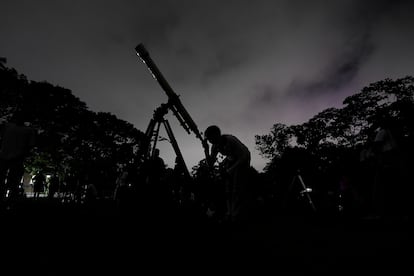Planets on parade: 5 will be lined up in night sky this week
You may need a pair of binoculars to catch Mercury and Uranus, which don’t shine as bright as the other planets. But the five-planet array will be visible from anywhere on Earth, as long as you have clear skies

Keep an eye to the sky this week for a chance to see a planetary hangout.
There’s a special chance this week to see five planets lined up in the night sky. Mercury, Jupiter, Venus, Uranus and Mars will gather near the moon in a planet parade. The best day to spot all five will be on Tuesday right after sunset. If you look out to the western horizon, you’ll be able to see them stretching up toward the moon. You may need a pair of binoculars to catch Mercury and Uranus, which don’t shine as bright as the other planets. But the five-planet array will be visible from anywhere on Earth, as long as you have clear skies.
Where and when can you see them?
The best day to catch the whole group is Tuesday. You’ll want to look to the western horizon right after sunset, said NASA astronomer Bill Cooke.
The planets will stretch from the horizon line to around halfway up the night sky. But don’t be late: Mercury and Jupiter will quickly dip below the horizon around half an hour after sunset.
The five-planet spread can be seen from anywhere on Earth, as long as you have clear skies and a view of the west.
“That’s the beauty of these planetary alignments. It doesn’t take much,” Cooke said.
Do I need binoculars?
Maybe. Jupiter, Venus and Mars will all be pretty easy to see since they shine brightly, Cooke said. Venus will be one of the brightest things in the sky, and Mars will be hanging out near the moon with a reddish glow. Mercury and Uranus could be trickier to spot, since they will be dimmer. You’ll probably need to grab a pair of binoculars.
If you’re a “planet collector,” it’s a rare chance to spot Uranus, which usually isn’t visible, Cooke said. Look out for its green glow just above Venus.
Does this happen often?
Different numbers and groups of planets line up in the sky from time to time. There was a five-planet lineup last summer and there’s another one in June, with a slightly different makeup.
This kind of alignment happens when the planets’ orbits line them up on one side of the sun from Earth’s perspective, Cooke said.
Sign up for our weekly newsletter to get more English-language news coverage from EL PAÍS USA Edition
Tu suscripción se está usando en otro dispositivo
¿Quieres añadir otro usuario a tu suscripción?
Si continúas leyendo en este dispositivo, no se podrá leer en el otro.
FlechaTu suscripción se está usando en otro dispositivo y solo puedes acceder a EL PAÍS desde un dispositivo a la vez.
Si quieres compartir tu cuenta, cambia tu suscripción a la modalidad Premium, así podrás añadir otro usuario. Cada uno accederá con su propia cuenta de email, lo que os permitirá personalizar vuestra experiencia en EL PAÍS.
¿Tienes una suscripción de empresa? Accede aquí para contratar más cuentas.
En el caso de no saber quién está usando tu cuenta, te recomendamos cambiar tu contraseña aquí.
Si decides continuar compartiendo tu cuenta, este mensaje se mostrará en tu dispositivo y en el de la otra persona que está usando tu cuenta de forma indefinida, afectando a tu experiencia de lectura. Puedes consultar aquí los términos y condiciones de la suscripción digital.










































